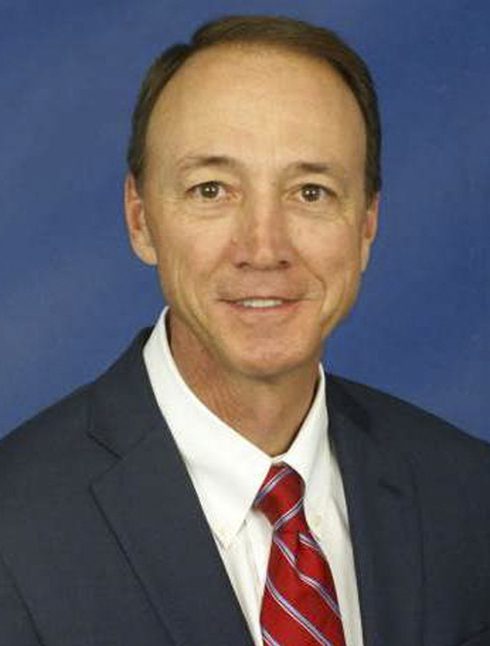Murky business at the water board
Last week, I wrote that the South Florida Water Management District Governing Board was about to cut the agency’s tax rate again, depriving the agency of another $21 million it needs for water supply and flood protection.
That happened. But it wasn’t close to being the big news from the board’s Thursday meeting.
That afternoon, an email from Board Chairman Daniel O’Keefe notified the district’s 1,530 employees that they were getting a new boss. Peter Antonacci would replace Blake Guillory (above) as executive director. That morning, after the item had been added late to the agenda, the board officially had hired Antonacci, who starts Oct. 1. The “discussion” of who will lead the most important public agency in South Florida took about five minutes.
O’Keefe’s email, however, gave no reason for Guillory’s departure. The email didn’t even say that Guillory was resigning. It just said that Antonacci was coming. It contained the usual platitudes—praising Guillory’s “vision and creative problem-solving”—to avoid saying that Gov. Rick Scott had forced Guillory out.
Yet that clearly had happened. Follow the trail.
• Scott has appointed or reappointed all nine water district board members.
• The Department of Environmental Protection, which oversees the five water management districts, had jawboned the board to change its initial July 16 vote against the tax cut—a tax cut Scott supported.
• Though Guillory supported the staff recommendation to cut the property tax rate, Guillory also stressed to the board in July that less money for 2015-16 would mean “a lot to make up,” and that without added revenue the district would face such budget challenges in 2016-17 that it might “go off a cliff.”
• Scott appointed DEP Secretary Jon Steverson.
• Steverson is a former director of the Northwest Florida Water Management District. Antonacci served on that agency’s governing board. In that role, Steverson drew praise from the governor for carrying out “restructuring”— layoffs and budget cuts.
The result is that a very capable engineer who dared to question Scott’s tax-cutting ideology has been replaced by a lawyer who has proved his loyalty to the governor as a hatchet man under similarly secretive circumstances.
In December 2014, a month after Scott won his second term, Antonacci was the governor’s chief legal counsel. Yet despite that role and despite being a former deputy state attorney general, Antonacci—as The Tampa Bay Times reported—told then-Florida Department of Law Enforcement Director Gerald Bailey that he had to resign or be fired. Scott wanted someone new. Antonacci gave no reason, although Bailey told the Times that he had refused requests by Scott’s campaign staff for FDLE favors.
Scott, however, lacked the authority to replace Bailey. The FDLE director reports to the governor and the Florida Cabinet, which includes the attorney general, chief financial officer and agriculture commissioner.
So Scott’s office arranged Bailey’s ouster by working through his aides and aides to the Cabinet officials. They decided a public matter in private Scott’s choice, Ken Swearingen, would replace Bailey.
When the matter came up at last January’s Cabinet meeting, Attorney General Pam Bondi, Chief Financial Officer Jeff Atwater and Agriculture Commissioner Adam Putnam went along without asking any questions. Their aides had told them that Bailey resigned voluntarily.
Of course, Bailey hadn’t. And surely even the water management district board members don’t believe that Guillory resigned voluntarily. None of them, however, was willing to cross the governor, and thus all of them abdicated their public role. Board member Melanie Peterson was especially arrogant, telling me that she wouldn’t comment “because I don’t have to.”
Instead, they focused on touting Antonacci, whom Scott also tapped to fill out the term of former Palm Beach County State Attorney Michael McAuliffe in 2012. O’Keefe gushed over Antonacci’s reputation in Tallahassee, where he has been working for the law firm of Gray Robinson. In addition to his time as deputy attorney general, Antonacci served as statewide prosecutor.
All of which would make sense if the water management district hiring its top lawyer. Antonacci has no relevant professional experience. O’Keefe cited that service on another water district board, but there’s no comparison. I’ve written about the district for 25 years and probably could serve competently on the board, but I wouldn’t be even a marginal candidate for the director’s job.
O’Keefe then noted that the district will need Tallahassee connections, of which Antonacci has many. Also, O’Keefe said, some of the district’s key issues are legal, especially the 27-year-old lawsuit about the quality of water entering the Everglades. A federal judge oversees Florida’s compliance with a court order to make the water clean enough that it doesn’t harm wildlife. The state still hasn’t met its goal.
In fact, the only Tallahassee connections the water district should need are the governor and the DEP secretary. They should be the district’s main advocates. Instead, Scott has used all the water districts, but especially South Florida, to show that he’s a tax-cutter.
Audubon of Florida Director Eric Draper believes that the South Florida district soon could lack sufficient money to carry out its primary missions: water supply and flood protection. The district remains nearly 400 employees under what it had when Scott took office. Property values are rising, but Scott insists that the district keep doing more with less and trying to distance himself from any responsibility. He called the Antonacci-for-Guillory swap “a decision by the board.” Sure.
Two years ago, Scott ran off Guillory’s predecessor, Melissa Meeker, even though she had overseen the initial massive layoffs and budget cuts Scott had demanded. Then, as now, Scott gave no explanation before hiring Guillory, who had been running the Southwest Florida Water Management District and at least had relevant experience.
We must assume that Scott wanted Guillory out soon. The board meets just once a month. There hadn’t been time even to agree on a severance. O’Keefe will do that.
Perhaps Antonacci will work out. Nothing about his hiring or Scott’s continued disdain for disclosure, though, offers any reassurance.
Delray beach update
I also wrote last week about City Manager Don Cooper’s hope that Delray Beach can start Phase 1 of its beach improvement plan in the spring. Which, of course, begs the question of how many phases there will be.
In an email, Cooper told me that he expects at least three phases, but that will depend on cost. Phase 1 would cover the walkway, parking meters and showers.
University Village
Rather emphatically, Boca Raton City Council members last week advised City Manager Leif Ahnell that they don’t what a speeded-up schedule for development of what Mayor Susan Haynie called “the last free-standing large parcel” of land in the city.
That would be the 80-acre site envisioned as University Village—a mix of residential, retail and medical north of Spanish River Boulevard and east of Interstate 95. There would be about 1,500 homes alone.
Normally, the council introduces a development ordinance for consideration after a project goes before the planning and zoning board. The developer wanted the ordinance introduced before the board had reviewed University Village. Such a change would compress the time in which the public had a chance to comment.
Though the council still wants to streamline the city’s permitting system, the council didn’t like that idea. But expect the project to get its review this fall.
Project Darwin?
Boca Raton raided its job-development fund last week, approving $200,000 as part of a $1.3 million incentive package. According to the staff memo, the money would go a company that has 57 employees in Boca and wants to add 160 jobs over the next three years.
The company, which is in the drug compounding business, reportedly has drawn interest from Oregon and Nevada. As usual, the company is not named. It goes by the label Project Darwin. The state would contribute $940,000 and the county $160,000. All money would be contingent on the company meeting job projections.
About the Author
Randy Schultz was born in Hartford, Conn., and graduated from the University of Tennessee in 1974. He has lived in South Florida since then, and in Boca Raton since 1985. Schultz spent nearly 40 years in daily journalism at the Miami Herald and Palm Beach Post, most recently as editorial page editor at the Post. His wife, Shelley, is director of The Learning Network at Pine Crest School. His son, an attorney, and daughter-in-law and three grandchildren also live in Boca Raton. His daughter is a veterinarian who lives in Baltimore.








